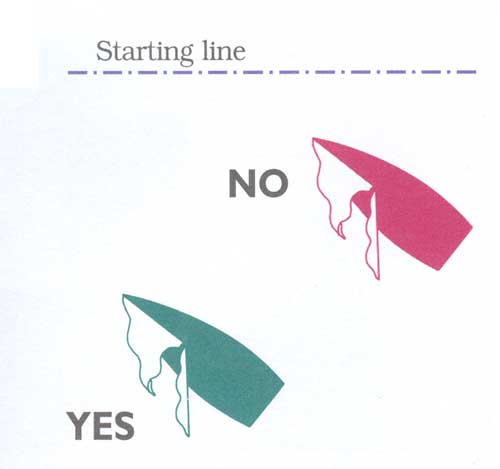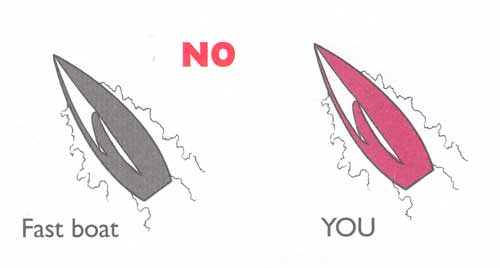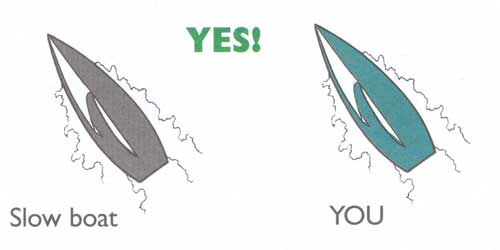Work On Your Starting Position
by David Dellenbaugh
The goal of your starting tactics is simpleóitís to get yourself into a
good position when the race starts. A Ďgood positioní is one that allows you
to do two main things: 1) Come off the starting line in the front row with
speed and clear air; 2) Follow your strategy for the first windward leg.
Tactically, your position at the start must consider two factors - the
location of the fleet as a whole (see discussion of clumps below) and the
actions of the boats that are right near you. Both of these will impact your
ability to position yourself for a good start. For example, if you start in
the middle of a huge pack of boats it may be difficult to get off the line
cleanly. Or if thereís another boat close on your lee bow at the start, you
will soon get pinched off.
One of the keys to positioning at the start is the ability to handle your
boat well in close quarters. In a dinghy you must be able to hold your boat
in place for quite a long time, turn your boat without moving forward and
accelerate from zero to full speed in as short a time as possible. In big
boats, you need a good sense of time and distance.
 |
| Avoid Ďclumpsí - look for holes Almost every starting line is like a piece of Swiss cheese. It has holes where there arenít many boats and clumps where the boats are packed tightly together. There are usually clumps at the ends of the line, and almost always at the Ďfavoredí end. Sometimes there are clumps, or holes, where you least expect them. You donít have to be a cheese connoisseur to realize that the odds of getting off the line in good shape are better if you start in a hole than a clump. In a clump itís hard to create space to leeward and find a lane of clear air; in holes itís much easier to come off the line with full speed.
|
Many of these boathandling skills are things you and your crew can practice
on your own. Find a buoy, for example, and see how long you can hold your
boat in position right next to it. Then sail away from the buoy, start a
countdown, and try to reach the buoy at full speed when your watch hits
zero. Good boathandling requires teamwork and a fair bit of practice.
As I mentioned before, knowledge of the racing rules is also key to the
execution of starting tactics. Tactics, by definition, involve boat-to-boat
maneuvers, and itís difficult to be confident about these if you donít fully
understand your rights and obligations under the rules.
 |
Fortunately, the rules are one sailing subject that you can learn without
having to be on the water all the time. Set a goal for this winter of
learning all the rules that apply at the starting line. Study the rulebook,
read books about the rules (I recommend Dave Perryís Understanding the
Racing Rules of Sailing Through 2008) and find chances to talk with people
who know a lot about the rules.
Besides smooth boathandling skills and a thorough understanding of the
rules, getting yourself into a good position at the start requires the
ability to execute some basic tactical moves. Here are a few rules of thumb
when you are approaching the start:
Line up on starboard tack.
We take this for granted because almost everyone does it. But there is a
very solid tactical reason here - boats on starboard tack have the right of
way. Yes, there are times when a port tack start will work (be sure to look
for those), but most of the time itís better to go with the flow by making
your final approach on starboard.
 |
| Keep your options open When youíre making a port-tack approach, donít let yourself get pinned by other boats. If youíre not careful, another port tacker to windward (C) will prevent you from tacking and force you farther down the line than you want. To avoid this, slow down or speed up so you maintain the option to tack or jibe whenever you want. If you get desperate, you can always head up to closehauled and use rule 19 to hail for room to tack at a starboard-tacker obstruction. |
Luff on a closehauled course.
When you are sitting on the line, luffing and going slowly, keep your boat
on an angle that is about 40 degrees or 45 degrees to the wind. This way you
can trim in and start accelerating without the need to turn your boat or
your rudder (both of which take time and slow you down).
 |
| Donít set up too close to the line A common mistake, often made by racers who are less experienced, is getting to the line too soon. You definitely want to be near the line at the start, but if youíre too close before the gun the only way you can build speed is by sailing on a close or beam reach. This is not good because it uses up your hole to leeward and takes you toward boats (to leeward and ahead) that have the right of way. Instead, hang back far enough from the line so you will have room to trim in on a closehauled course and accelerate to full speed by the time you reach the starting line. |
Avoid boats close to leeward.
You should never start a race with a boat close to leeward (if you can
possibly avoid it), so carve out a hole on your leeward side and guard it as
you approach the line. The size of the hole you need is at least half a
boatlength or so, but depends on a number of factors including wind
strength, waves, line angle and your type of boat.
Start with your bow even.
Unless you know the boats around you are over the line early, you should
always start the race with your bow even or ahead of theirs. The most common
error here is not accelerating until itís too late, so keep an eye on the
boats nearby and be ready to trim in when they do.
 |
| Set up above a Ďmarshmallowí In terms of positioning, the boat on your leeward side at the start may be the most important factor of all. If this boat is too close, too fast or points too high you will have a very hard time staying in the front row after the start. So donít leave this variable to chance. Pick a slower boat and set up just to windward of them. This will give you a much better chance of having a good start (and race) than starting next to your fleet champion. |
 |
From a tactical point of view, itís important to anticipate what may happen
and to be flexible about how you respond. If youíre stuck in a pack with 45
seconds to go, for example, donít be afraid to bail out and find another
hole.
Dave publishes the newsletter Speed & Smarts. For a subscription call:
800-356-2200 or go to:
www.speedandsmarts.com
All contents are copyright (c) 2006 by
Northern Breezes, Inc. All information contained within is deemed reliable
but carries no guarantees. Reproduction of any part or whole of this
publication in any form by mechanical or electronic means, including
information retrieval is prohibited except by consent of the publisher.